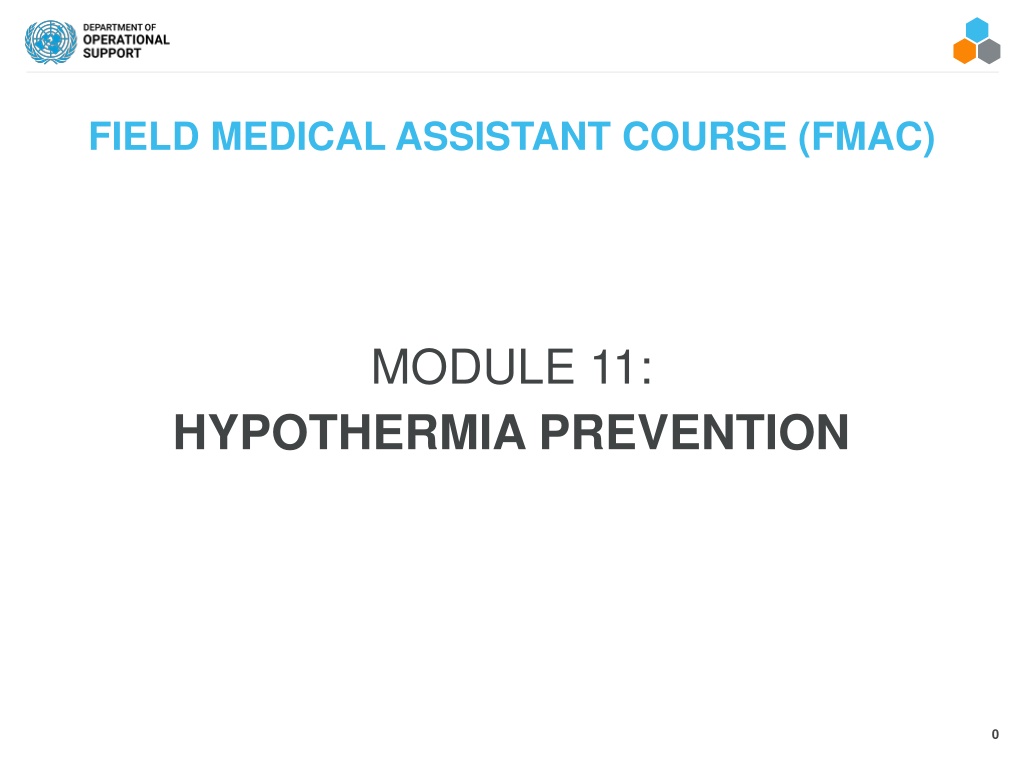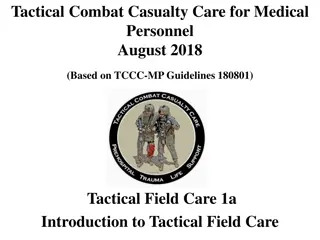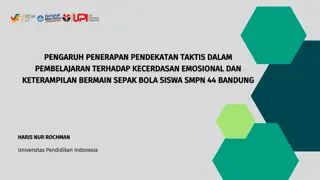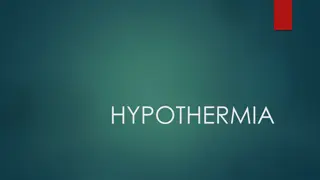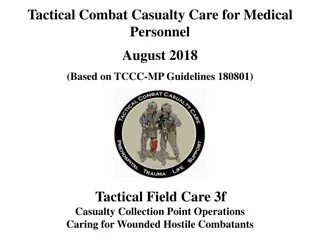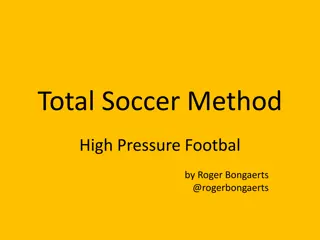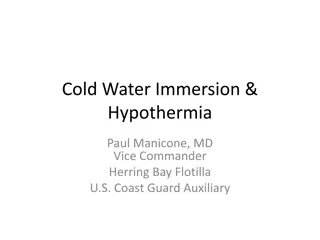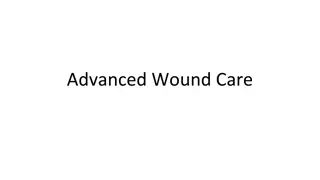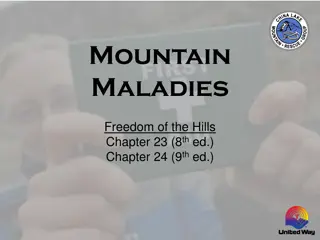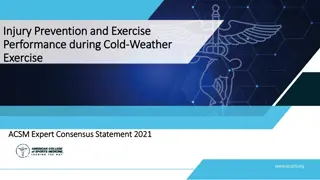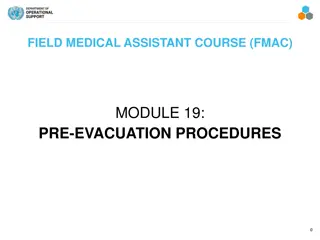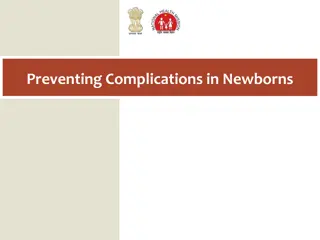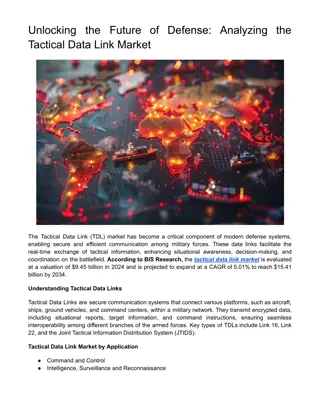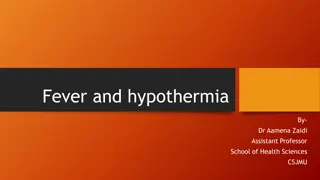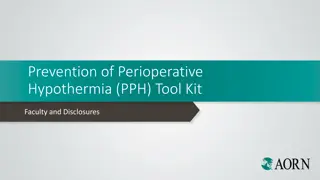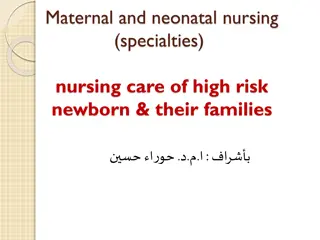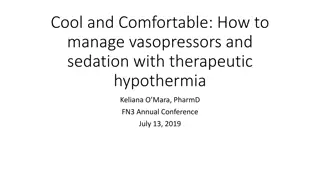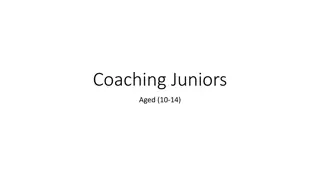Comprehensive Hypothermia Prevention Measures in Tactical Field Care
Hypothermia is a critical concern in trauma casualties, especially in cold environments. This module covers the importance of preventing hypothermia, strategies to minimize exposure, and active and passive warming techniques. Proper hypothermia prevention can significantly impact the outcome of trauma care scenarios in the field.
Download Presentation

Please find below an Image/Link to download the presentation.
The content on the website is provided AS IS for your information and personal use only. It may not be sold, licensed, or shared on other websites without obtaining consent from the author. Download presentation by click this link. If you encounter any issues during the download, it is possible that the publisher has removed the file from their server.
E N D
Presentation Transcript
FIELD MEDICAL ASSISTANT COURSE (FMAC) MODULE 11: HYPOTHERMIA PREVENTION 0
TACTICAL FIELD MEDICAL AID (TFMA) ROLE-BASED TRAINING SPECTRUM ROLE 1 CARE NONMEDICAL PERSONNEL Buddy First Aid Field Medical Assistant You are HERE MEDICAL PERSONNEL Paramedic Nurse Doctor 1
STUDENT LEARNING OBJECTIVES TERMINAL LEARNING OBJECTIVE T12 Given a combat peacekeeping or non-combat peacekeeping scenario, perform hypothermia prevention measures on a trauma casualty during Tactical Field Care in accordance with TFMA Guidelines EO65 Identify the progressive strategies, indications, and limitations of hypothermia prevention of a trauma casualty in Tactical Field Care EO66 Demonstrate active external warming hypothermia prevention measures on a trauma casualty EO67 Identify passive hypothermia prevention measures on a trauma casualty 2
TACTICAL FIELD CARE MARCH PAWS DURING LIFE-THREATENING AFTER LIFE-THREATENING MASSIVE BLEEDING #1 Priority PAIN AIRWAY ANTIBIOTICS RESPIRATION WOUNDS CIRCULATION SPLINTING HYPOTHERMIA / HEAD INJURIES 3
HYPOTHERMIA PREVENTION HYPOTHERMIA Hypothermia is the decrease in body temperature Even a small decrease in body temperature can interfere with blood clotting and increase the risk of bleeding to death Casualties in shock are unable to generate body heat effectively Hypothermia is a problem for casualties with haemorrhagic shock, even with warm, ambient temperatures IMPORTANT CONSIDERATIONS: A lower body temperature may not be an indicator of hypothermia; it may be due to exposure to a cold environment 4
HYPOTHERMIA PREVENTION HYPOTHERMIA PREVENTION Minimize the casualty s exposure to the elements Keep protective gear on or with the casualty if feasible Replace wet clothing with dry, if possible You can better prevent hypothermia by getting the casualty onto an insulated surface as soon as possible 5
HYPOTHERMIA PREVENTION HYPOTHERMIA PREVENTION Hypothermia is much easier to prevent than to treat Begin hypothermia prevention as soon as possible Decreased body temperature interferes with blood clotting and increases the risk of bleeding Blood loss can cause a significant drop in body temperature, even in hot weather Get the casualty onto an insulated surface as soon as possible. M A R C H 6
HYPOTHERMIA ACTIVE HYPOTHERMIA PREVENTION Your medical personnel will distribute the active hypothermia blankets based on unit mission and load Active hypothermia blankets are activated when their heating elements are exposed to air Active hypothermia blankets are applied to a casualty who cannot generate their own heat, but not directly on their skin because the activated blankets can cause burns M A R C H 7
HYPOTHERMIA ACTIVE HYPOTHERMIA PREVENTION KEY POINTS: If an active hypothermia blanket is not available, a combination of the passive warming blanket and an active warming blanket may also be used Active hypothermia treatment uses heating sources to warm the casualty Oxygen levels at higher altitudes may not be enough to sustain the chemical reaction required to generate heat Apply the active warming blanket from the active hypothermia blanket to the casualty s torso (not directly on the skin), and cover the casualty with the passive hypothermia shell M A R C H 8
HYPOTHERMIA PASSIVE HYPOTHERMIA PREVENTION Passive hypothermia materials provide heating by: Keeping the casualty s body heat contained in the passive material Keeping the casualty off the ground M A R C H 9
HYPOTHERMIA PASSIVE HYPOTHERMIA PREVENTION KEY POINTS: Blood loss can cause a significant drop in body temperature, even in hot weather Wrap the entire blanket-like shell (or passive heating materials) completely around the casualty, including the head Do not cover the face Place a poncho or blanket under the casualty to protect them from the temperature or dampness of the ground Passive hypothermia prevention does not reverse the hypothermic process If no rewarming equipment is available, then use dry blankets, poncho liners, sleeping bags, or anything that will retain heat and keep the casualty dry Keep the casualty off the ground M A R C H 10
HYPOTHERMIA PREVENTION VIDEO HYPOTHERMIA PREVENTION Video can be found on DeployedMedicine.com 11
SKILL STATION Hypothermia (Skill) Active/passive external warming hypothermia prevention 12
SUMMARY We defined hypothermia We discussed active hypothermia management/prevention We discussed passive hypothermia management/prevention KEY POINTS: Passive hypothermia prevention DOES NOT reverse the hypothermic process Active hypothermia, when at high altitudes, may not be enough to sustain the chemical reaction required to generate heat 13
CHECK ON LEARNING Why is it important to keep a trauma casualty warm even if it is a hot environment? What is the difference between active and passive hypothermia management? 14
